Tags
"education"
Elementary School Psychology: Maggie MacLean, Winter Shadow 2016
I participated in a two-day shadow with Moira Tofanelli, a school psychologist at two different public schools in Portland. As an art major completing a thesis that draws heavily from the field of psychology, I was excited to see where a career in psychology could take me in Portland. I will be graduating in May and I am thinking about what kind of job I would like in the near future, and teaching seems to be an obvious next step for me. It was a great exercise for me to think about what kind of school I want to be a part of and see how the public schools in Portland vary.
It was interesting for me to compare the two schools I visited, as they were very different in terms of philosophy and educational goals. In the developmental psychology class I am taking this spring, we have been focusing on different models of human development and the kinds of guidance and parenting strategies that support each model. The first school I visited, the Creative Science School, uses a constructivist educational perspective. Jean Piaget, a psychologist influential in the 1970s, is the best-known proponent of this philosophy. Constructivism values learning through experience and independent problem solving. In general, Piaget viewed child development as a series of stages, and children as tiny scientists who learn about their world through experimentation and add new information to existing mental schemas. In the classroom, a constructivist approach often manifests as lots of group work, experiential projects, and integration of different classroom subjects.
To me, Creative Science seems big and colorful and full of movement and the evidence of children. There are art projects all over the hallway walls, glitter-covered handprints, and photographs of the students. I had forgotten what it is like to be in an elementary school. Everything is kid sized and chaotic in the way things are when tiny humans spend six hours a day in an enclosed space.
Continue reading Elementary School Psychology: Maggie MacLean, Winter Shadow 2016
Saturday Academy: Orion Cohen, Winter Shadow 2016
It is difficult to articulate exactly how I imagined non-profits before my time at Saturday Academy. My mental image resembled the bureaucratic equivalent of a panda, accepting donor funds, holding events, and slowly ambling towards its goal of benefiting the greater good. At Saturday Academy I quickly learned that whatever my conception was, it was utterly and completely incorrect. A non-profit is more like a spider in the center of a vast and intricate web of connections. It interfaces with donors, volunteers, and consumers to harness the latent desire of a community to improve itself and manifest that desire into a powerful force for good. Saturday Academy gives thousands of curious students the opportunity to indulge their interest in science with the help of talented community professionals. On a weekly basis, Saturday Academy accomplishes the incredible logistical feat of organizing hundreds of students and teachers into multiple locations across the city. When I asked Jeri Janowsky, Saturday Academy’s director and one of the most capable people I have ever met, how this was done, she jokingly told me, “complete chaos.” My time at Saturday Academy gave me enormous respect for both the mission and staff of the organization.
Additionally, I gained an understanding of the organization and operation of non-profits through a series of semi-independent projects assigned by the staff. Rather than merely observe the organization, I contributed to it, which was rewarding and educational. My observation of Saturday Academy’s structure taught me the most important lesson of all, the necessity of networking. I discovered that what I had negatively conceived of as schmoozing is in fact of a critical part of individual and organizational success.
It would be difficult to envision a more positive externship experience than the time I spent at Saturday Academy. I am incredibly grateful for the opportunity to work at Saturday Academy and honored that I was chosen as extern. I am also thankful for the hard work of The Center for Life Beyond Reed that facilitated the experience.
Continue reading Saturday Academy: Orion Cohen, Winter Shadow 2016
Astronomy at the University of Michigan: Sarah Racz, Winter Shadow 2016

The first thing I did when I found out I was accepted for the Winter Shadow program in Astronomy at the University of Michigan Ann Arbor was look into getting a parka. I was excited to visit Ann Arbor for the first time, and really hoping for some snow.
I stayed in Ann Arbor for a week, and left with unending love for what has become my favorite diner of all time.
I worked with a Mario Mateo, who is an astronomer at the University of Michigan. The project I worked on sought to measure the dependence of the magnitudes of RR Lyrae stars upon metal abundance. RR Lyrae stars are variable stars, known for having short periods. All the stars we observed were from the globular cluster Omega Centauri, which is a cluster known for having a range in the metallicities of its stars. All the data was from a telescope in La Serena, Chile that Mario had built. During the week I wrote several scripts in Python to read from huge files of data and run data analysis.
Child Psychology with Dr. Amy Summers: Maddy Wagar, Winter Shadow 2016
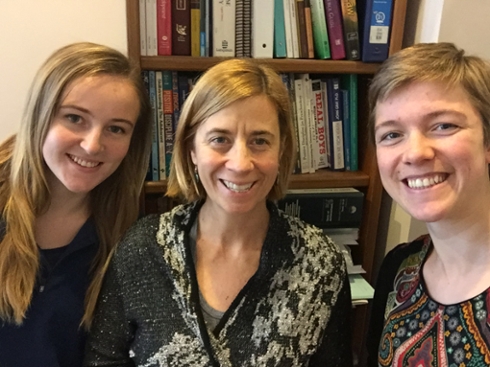
Maybe because I’m a Reedie, getting an education at a college that tucks grades out of sight and celebrates the weird and wonky types of intelligence that stick out at awkward angles from standard boxes. Perhaps because, as my mom says, I was raised in a hippy era when testing kids was “uncool.” For whatever reason, I admit I entered into my weeklong shadow with Dr. Amy Summers, a private psychologist who specializes in administering tests to kids to gather information about cognitive development, IQ, and possible learning disabilities, with a bit of a bias. The bias wasn’t even due to an issue of ethics, I think I just heard words like “testing” and “assessment” and “diagnosis,” and thought these translated to numbers, objectivity, and standardization. In all honesty, I thought the work would be a little boring. I was beyond wrong!
I simply did not know enough about psychological testing to realize how interesting, exciting, and nuanced it really is. I’m so grateful to this externship and everyone who made it possible. One week with Amy opened my eyes to some really cool aspects of psychology that I never knew existed, and inspired in me a real fascination with the process of psychological diagnosis.
Amy let myself and my fellow Reed student shadower Jocelyn Hansson follow her through every step of the process of assessing a 5th grader suspected of having ADHD or ADD. Amy works predominantly with young children, mostly to administer IQ tests to kids whose parents are hoping they qualify for a highly capable school or program, or to test for a learning disorder/ADD/ADHD.
Child Psychology with Dr. Amy Summers: Jocelyn Hansson, Winter Shadow 2016

I decided to do the winter shadow program because while I’ve been certain that I’d be a psychology major for a long time, I have been struggling to figure out what specific area in psychology I want to pursue. When I saw Amy Summer’s winter shadow program I knew I had to apply. Amy Summers Phd., is an educational psychologist who administers psychological tests to children. She administers IQ tests to children hoping to apply to highly capable school programs and tests to children suspected to have a learning disorder or attentional problems. I already had an interest in learning disabilities and ADHD, but I was interested in exploring and learning more about the various different job opportunities within this field. Over the course of my week shadowing Amy, my externship buddy Maddy and I learned about the responsibilities of an educational psychologist. We were also introduced to others in the same field, and the different kinds of educational backgrounds they had. We learned about learning disorders, ADHD, child IQ scores, and the tests that score them while also observing and even sometimes getting the opportunity to administer some of these tests.
Perhaps the most exciting parts of my externship experience involved administering tests to the young children. Maddy and I were given the opportunity to prepare and administer tests to the two 4 year olds who were receiving IQ tests (these tests were non-essential, so we couldn’t mess up the results of the testing). It was sort of crazy to see how IQ is tested in 4 year old children. Some of the tests made sense to me, such as the test that looked at processing speed, but others were more unusual. For example, a block design test had the children arrange colored blocks to match a simple pattern. It was weird to hear that an ability to understand and reproduce diagonal lines is considered to be advanced spatial-visual ability in 4 year olds. These were super sweet and intelligent kids, but it was a shock to see kids this young being exposed to a convoluted testing process with the goal of getting them into a high achieving school or kindergarten. I was glad Amy was more than happy to talk about my conflicting feelings about the schools, and she ended up giving me a lot to think about. We talked about things like the instability of young children’s IQ scores, the status element of having one’s children attend these schools, along with the effects of the different schooling children from high and low socioeconomic status receive.
During the week Amy also assessed an 8 year old who was being tested because of a suspected learning disorder. Maddy and I spent a day observing him in his school environment. While we were there we were able to talk to people worked in jobs different than Amy’s that were in the same realm of interest. I learned not only about jobs related to educational psychology, but also about some interesting methods geared to teach children with significant learning disabilities to read. When this boy came into Amy’s office, we were able to both observe his testing, and administer some tests ourselves. I came into this experience thinking I knew a lot about learning disorders and ADHD, but found that I actually knew very little about the tests for these disorders. One of the most interesting things I learned about these tests was the fact that there are different spelling errors that indicate different kinds of problems. Simply put, some spelling errors make phonological sense, and don't indicate much, while others might be indicative of difficulties understanding sounds and their corresponding letters. I think the most rewarding experience of my whole shadow program was looking critically at this boy’s performance on the tests. It was cool to see Amy look at certain test results, come up with a hypothesis, and administer certain tests to look into her hypothesis. We were treating this boy’s development and abilities sort of like a puzzle. I’m glad I was comfortable enough to put forward my own ideas and hypotheses about this boy.
Montgomery High School: Jeannette Phan, Winter Shadow 2016
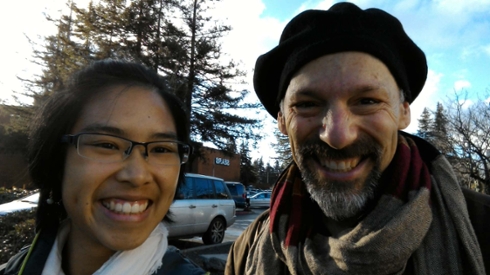
When I first considered doing a Shadow, I was studying abroad in Buenos Aires. A great many things happened to me during that semester, and just about as many questions, too, about where I’m going to be and what I want to do after Reed. Wondering how I was supposed to utilize and mold my Reed experience into something conducive to my future. Even the answer to what sort of field I wanted to go into was up in the air. These questions have only become more dire as I have been embarking on the last half of my undergraduate phase. So upon hearing about the opportunity Reed was offering students to shadow Reed alumni, I thought, what better way to help me examine this dilemma.
I didn’t know what kind of shadow I was looking for, besides looking for one where the person I would be shadowing could advise me on how to navigate the murky and amorphous decisions that I would soon have to make.
I had always thought of a career in teaching as an option; sometimes as my one an only option, and at other times as a backup should I never find anything better. As it were, at this point the playing field was level for all possible careers. I just wanted to know what careers were available and how one gets there. How do careers happen? For surely they are not always dependent on the linear development of one’s schooling, from grade school and higher education. Clearly, my problem was a simple lack of exposure to the realties of a career beyond the fanciful notions of stability and mundane complacency.
Continue reading Montgomery High School: Jeannette Phan, Winter Shadow 2016
East Bay Center for the Performing Arts: Isabel Lyndon, Winter Shadow 2016
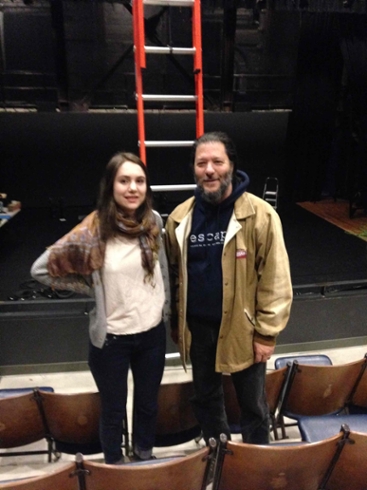
This winter, I spent four days at the East Bay Center for the Performing Arts in Richmond, California. I shadowed Jordan Simmons (Reed ’78), but I also had opportunities to work independently, with other interns, and with various members of the faculty and staff.
The Center, which includes a theater, a dance studio, practice and rehearsal rooms, and office spaces, is housed in a beautiful renovated building. When I arrived, Ruthie, the Deputy Director of Programs, took me around the Center, introducing me to everyone we ran into. She told me what they did at the center, professionally, but she also alerted me to other details, such as: one employee made great cheesecake and another was passionate about sneakers. Everyone had an amazing set of combined skills or passions. Ruthie herself, I learned, had degrees in both social work and jazz piano, and this kind of combination was not unusual among the staff.
Founded in 1968, the Center offers on-site classes, in school and after school programs for students in the Richmond area, ensembles, performances, college and career counseling, and internships. When I visited, the Center was in a “dark week,” or a period with private lessons and rehearsals but no regular classes. Even so, sometimes I would walk downstairs and come upon a student in a piano lesson. One afternoon, the sounds of an alumni band floated up from a first floor rehearsal room to the offices upstairs. Usually, the Center offers lessons in everything from violin to West African Dance, acting to oboe, plus jazz theory, capoeira, Mien/Laotian ceremonial dance, stage combat, ballet, and more.
Publishing and Education with Ruth Werner: Serena Offenbaker, Winter Shadow 2016

For my Winter Shadow, I stayed with Ruth Werner and her family. Ruth works from home where she juggles various projects related to her role as an author, artist, and educator, specializing in pathology and massage therapy. I had the fortune of getting to know her and her family, while getting some insight into publishing. Unfortunately, due to some health related concerns I was unable to engage with the opportunity as fully as I would have liked.
I did, nonetheless, have a rewarding experience. Speaking to Ruth about the intricacies of her work helped me realize the various approaches one can have into the field of education, despite my previous misconceptions of its limits. Seeing the way that she interacted with the field and others in it showed me how I might incorporate my own interests, skills, and passions into my educational pursuits without having to sacrifice different aspects of my identity. For example, Ruth talked about how she majored in theater at Reed but that her time here “made it clear I [Ruth] could go into any direction I wanted” stating that she “never felt constrained to follow any particular path” because she was supported by Reed to study anything that made me passionate and to trust that that would work out. And despite theater belonging to an entirely, seemingly disparate realm, she believes that her practice in the area helped her develop skills that were transferable to her role as an educator. Together we spoke at length about the importance and marketability of effective communication, which gave me confidence about moving forward into the world of publishing.
Ruth and I also talked about the significance of having vision, of being imaginative, problem solving, and being open to failure. She gave me some very valuable advice about pursuing publishing, which I’d like to share for others who might be pursuing it as well:
Saturday Academy: Hadley McCammon, Winter Shadow 2016
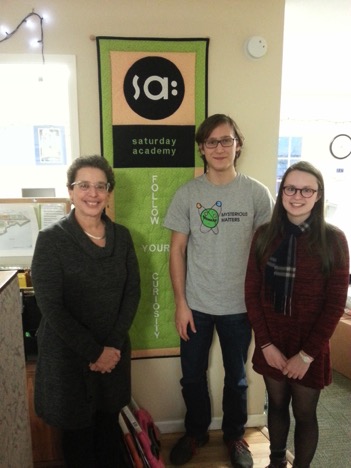
In my first email conversation with Dr. Jeri Janowsky, my winter shadow sponsor, she sent me an article explaining how the education gap between high socioeconomic status (SES) children and low SES children grows in the summer time but stays constant during the school year (Beth M. Miller, 2007). The article explained that this phenomenon is largely a due to the fact that high SES students usually have the opportunity to enroll in enriching summer camps, while low SES students do not.
Saturday Academy aims to bridge this gap by offering classes on Saturdays and over the summer to students of all income levels. This January, I had the opportunity to work for Saturday Academy in Portland for two weeks. I was struck by the non-profit's dedication to a single mission: to level the playing field for all students. As a result, I learned the importance of having a strong mission for non-profits. During a staff meeting I attended while at Saturday Academy, Jeri continuously pushed her staff to share any news they had on their projects, but more importantly, to make sure they understood how everything they were doing fit into the overall mission of Saturday Academy.
Over the course of the two weeks I spent working and learning at Saturday Academy, I also learned how non-profits function successfully. The role of the non-profit is to collect, organize, and distribute the resources of the community in order to accomplish a specific goal. In the case of Saturday Academy, bettering the education of the community’s children. Saturday Academy collects grants and the expertise of community members who instruct their classes, organizes them and provides them with guidance, and then distributes them to the community by way of classes.
Continue reading Saturday Academy: Hadley McCammon, Winter Shadow 2016
North Seattle College, Haley Tilt, Winter Shadow 2016
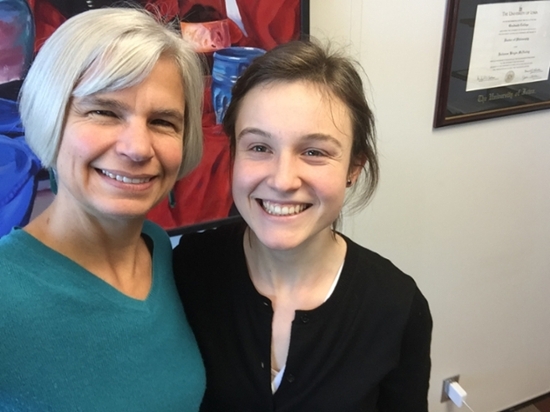
Julie and Haley at Julie's office.
Two days ago I arrived at Julie Kirgis’s home overlooking the Puget Sound. Julie is the Dean of Arts and Humanities up at North Seattle College, but she also has a strong background in sociology research. Since I hope to go into education administration or research (I don’t know which yet), hanging out with Julie for a few days seemed like an awesome opportunity.
That first evening, Julie and I made a quiche together in a pie pan whose generous depth resulted in a soupy final product. Tom, Julie’s husband (and a Reedie), recommended that we flip the quiche upside-down in a saucepan and drain off some fluid. Since that made the crust soggy, I suggested we put it back in the oven. After three hours the quiche looked like we’d run it through a centrifuge, so much had it separated into its component parts. 
Coming away from it all, I want to emulate the way Julie goes above and beyond to inspire a sense of community among her faculty and a sense of trust between them and herself. Of all the administrators “on the dark side” (according to the faculty), Julie’s faculty really seem to believe that she has their best interests at heart—because she does, and she lets them know it. I got to see Julie lead large meetings, meet with all of the North Seattle deans in the “cone of silence,” and support her faculty one-on-one. On one occasion, a faculty member wanted to come in just to vent that she was planning to overload her own class by three students. She wanted to do it because she knows that these students really need the class, but for her this meant extra grading and no extra pay. Julie was the listening ear who acknowledged that no, that’s not fair. But at the same time, as an administrator, Julie balances the budget and makes sure that her division isn’t running classes they can’t afford (classes without enough butts in seats). That means she’s also responsible for cutting classes and trying to get classes as full as possible. She’s often responsible for making unpleasant decisions that mean fewer jobs for teachers and cancelled classes for students. The fact that her faculty still trusts her and comes to her with their frustrations is remarkable.
Continue reading North Seattle College, Haley Tilt, Winter Shadow 2016
Winter Externship 2015, Speech and Language Pathology with Daniela Deyoung,Qingyang Xie
This past winter (2014), I shadowed Daniela Deyoung, a speech and language pathologist at the Portland Public School Early Childhood Team, for two weeks in January. Dani is mainly in charge of the transition from preschool to kindergarten for children with development delays, so she not only does speech development evaluations, but also communicates with preschool and kindergarten teachers and therapists to help with a smooth transition for children with special needs at school. Dani works with both English and Spanish speaking children. I followed Dani around the city to different meetings with parents and school staff and to observation sessions of children who need evaluations. Thanks to Dani, I also got to observe her colleagues during their evaluation sessions of children who were brought to the Early Childhood Team by parents with concerns of language or general development delay. It was very exciting and fun to learn about the child language development and observe the diverse tasks she and her colleagues perform on a day to day basis. Everyone was very friendly and helpful and was very patient with my questions.
I applied to the externship because I am very interested in languages and would like to learn more about the language development process of children. It was also a great opportunity to explore a completely new field. Dani was very engaged and helpful in the process and I learned a lot about autism and typical and non-typical child development at different age groups. Since Dani works with many children who fall in the autism spectrum, she started sending me articles about autism spectrum before the externship started and familiarized me with the symptoms. She was a great teacher and pointed out the children’s behaviors that might be indicators of autism to me during the observation sessions. She also gave me the opportunity to apply the autistic symptoms I learned by taking observation notes and gave me detailed feedback on them. I learned a great deal about child development from her within two weeks.
One important thing I learned is the importance of child play. Child play is an indicator of children’s social skills, their motor development and their intelligence development in general. Child play should be functional, meaning that children should play the toys the way they are designed to be played, have a story about what they are playing, or use the toys in innovative but still sensible ways. It is a lot of the times an imitation of adults’ activities—like cooking, driving cars, building a house, etc—and sometimes require cooperation with other children. When a child is not playing functionally, but uses a toy to make repetitive movements such as dragging a train in a circle nonstop or staring at car’s wheels spinning, it might be an indicator of autism, but of course the language pathologist has to see other symptoms of autism to qualify the child for special education. It was fascinating for me to learn about the functions and complexity of child play and helped me understand the typical behaviors of children.
Continue reading Winter Externship 2015, Speech and Language Pathology with Daniela Deyoung,Qingyang Xie
Citizenship and Legalization in Immigrant Communities: Portland based Immigration Advocacy, McGill Lawrence Internship Award, Francisca Garfia
This summer, McGill Lawrence Internship Award recipient Francisca Garfia, '17, Anthropology, worked with the portland-based immigrant rights organization CAUSA. Read ahead for her impressions:
As the daughter of Mexican immigrants, the struggle for legalization in the immigrant community has been central to my upbringing; I knew entire families who feared the separation of deportation, I had friends who were unable to attend college due to their legal status. This familiarity with the human side of illegal immigration led me to Causa, Oregon’s leading immigrant rights advocacy group. Causa services the Pacific Northwest immigrant community by educating them on their rights and opportunities for legalization. One way they do this is through community workshops; Causa provides access to legal forms and low cost attorneys since the legalization process is complicated and costly. The majority of my summer internship centered on a workshop, which not only served as a way to support the local immigrant community, but also pledged our solidarity to immigrant communities nationwide.
When I began planning this internship, President Obama had recently announced the expansion of DACA (Deferred Action for Childhood Arrivals) and DAPA (Deferred Action for Parents of Americans). Immigrants across the nation were abuzz with the news; if enacted, millions of undocumented immigrants would be legalized! However, the celebration was short lived as Texas and other states filed a lawsuit that prevented the implementation of the programs. As a result, immigrant advocacy groups that had hoped to help people become “DACAmented,” now had to focus their efforts on convincing the fifth circuit court that DACA was vital to these communities, and that these individuals were Americans despite their lack of documentation.
Continue reading Citizenship and Legalization in Immigrant Communities: Portland based Immigration Advocacy, McGill Lawrence Internship Award, Francisca Garfia
Summer School at McCoy Academy, McGill Lawrence Internship Award, Kelli Collins

Kelli Collins '15, McGill Lawrence Internship Award recipient, is teaching summer school to econmically disadvantaged youth through the Portland-based nonprofit Oregon Outreach.
Teaching at McCoy Academy has been fun, challenging, rewarding, and eye opening. I went into this experience hoping to learn how to effectively educate youth who come from difficult, often at-risk backgrounds. I've realized that many of the teachers who devote themselves to this demographic spend decades asking themselves these same questions and learning more every day about the teaching methods that are most and least effective.

The Birth of a New Life: Davis Project for Peace, Emmanuel Enemchukwu
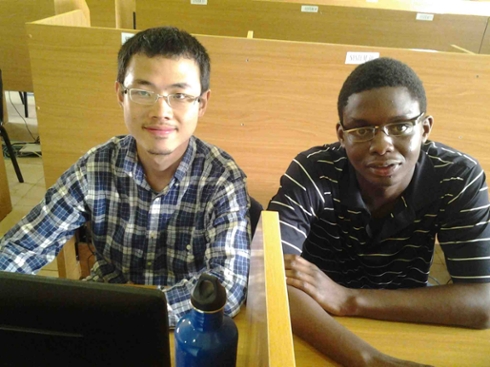
Emmanuel Enemchukwu, junior economics major, was a recipient of the Davis Project for Peace award. The following post contains his experiences implementing his project in Nigeria at the Federal Government Academy.
About half a year now separates me from the time I spent at the Federal Government Academy (FGA) Suleja Nigeria. At FGA Suleja, I executed the Davis project for peace with my colleague, Zhe Li. FGA Suleja, Nigeria, was my alma mater, and its contribution to my moral and intellectual development leaves me forever indebted to it. As such, it was with great zeal that I embarked on the project hoping to contribute the most possible in the small but relevant opportunity that I had been afforded.
The Federal Government Academy Suleja is located in one of the most southern regions of Northern Nigeria. Suleja with its beautiful hills is a town in harmony with itself and its surroundings, but this harmony seems fragile in the face of the current ethno-social turmoil perpetrated by Boko-Haram in North-Eastern Nigeria, a region of close proximity. Once in a while, the scourge of the much-reviled Boko-Haram breaks out of its enclosure in North Eastern Nigeria and into the area of Suleja. But beyond this fear of conflict, we saw peace and prosperity in a school that boasts of some of Nigeria’s smartest young minds. We define peace, with regards to the secondary school students, as the existence of social innovation and an infrastructural platform for students to optimize their academic growth potentials in a violence-free environment.
The Smiles of the Children: Marshal Academy Internship in Pakistan, McGill Lawrence Internship Award, Ahyan Panjwani
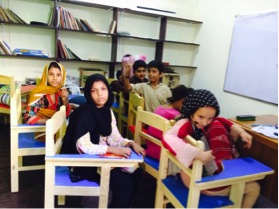
During the scorching summer of 2014, I worked with Mashal Academy, an alternate school for underprivileged children in Neelum Colony, a squatter settlement in Karachi, Pakistan. The initiative is primarily run by high school students from The Lyceum; they spend afternoons and early evenings with primary school level children from the area helping them with Math, English, Urdu (the national language) and basic sciences which are part of the Department of Education endorsed curriculum. Mashal was based in a single room, rented by the high school students where they used to help around 15 children with these subjects.
However, because of the superior quality and consistency of education that the students offered, there was a surge in the number of children wanting to attend Mashal. In light of this, I worked with the students to lease a new space which is much bigger and accommodates 34 children and the activities that the mentors plan for them. The new place has two rooms and a huge veranda allowing the students to be divided into two groups depending on their prior academic learning. Over the summer, we also created lesson plans for new subjects including Music, Arts, Drama and Physical Education while also allotting an hour every week for reading time. Given the pedagogical methods in the schools usually available to the children, these new additions are phenomenal – almost unheard of. We also laid ground for two other programs at Mashal: monthly medical check-ups for the children by a qualified pediatrician and a daily lunch program. Both of these are aimed at incentivizing parents to send their children to school while also providing quality services in area where infrastructure for health and hygiene is almost negligible.
Most importantly, we put in place a sustainable donor model for Mashal over the summer. Since the school was housed in smaller premises earlier, the rent was not a very big issue. However, the new house and the expanded services being offered mean that the operating costs have risen substantially. I guided the students towards finding and approaching donors who would pledge to chip in with the costs on a monthly basis for an entire year before renewing their commitments.
Continue reading The Smiles of the Children: Marshal Academy Internship in Pakistan, McGill Lawrence Internship Award, Ahyan Panjwani
PSF Project, Campus Within Walls, Part 3
I went to where we are supposed to find society’s worst. What I found were people working to be their best.
I spent five weeks attending class with our outcasts, our pariahs, our unseen. The ones we place in shadow and in darkness, out of view, all the better to construct them as distant abstracts, faceless and certainly heartless causers of violence and tragedy and badness. Criminals. Violators. Undeserving of society, deservedly stripped of rights.
Monsters.
Continue reading PSF Project, Campus Within Walls, Part 3
A Long Overdue Reflection, McGill Lawrence Internship Award, Sunny Yang
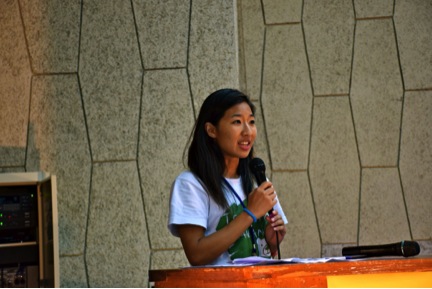
Me being the MC for the closing ceremony of the summer pre-service training.
The past two months have been a whirlwind of events, feelings, and encounters. Quite different from my original imagining of this summer internship, yet equally as fantastic, or even more so.
Originally, the plan was to spend half of my time doing a field research project in rural regions in Taiwan for the organization Teach for Taiwan, and the other half of the time would be spent assisting the organization in finding mentors for Teach for Taiwan's pilot cohort teachers. Well, plans don't always work out, especially independent internship projects like this.

The Devil is Made of Plastic

There are over 2,500 miles of coastline in the Kodiak Archipelago, and there are about 3,000-3,500 Kodiak brown bears that call their island namesake home. This means that if all those salmon-stuffed ursas were lined up along the many beaches and bluffs of their Alaskan archipelago each bear would pretty much have its own mile of coast. There are only about 1,300 miles of coastline in the entire west coast of the United States of America, from Bellingham, Washington to San Diego, California, and not nearly that many bears. Think about that one. In July, a team of eight people, myself included, went to Tugidak Island on the southern end of the Kodiak Archipelago and walked a mere 2.5 miles, or one one-thousandth, of Kodiak’s coast, picking up marine debris. Eight to ten THOUSAND pounds of marine debris in three days. Now wrap your head around that number.
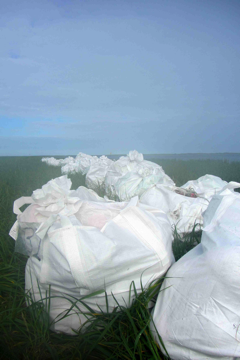 What is marine debris? It’s nothing more than a fancy term for trash. Garbage. Waste. Junk. And on top of whatever your word of choice is for human carelessness, you can also be sure to call it totally destructive and 100% preventable. 100% preventable, really? Yes, friends, as powerless as we all have been conditioned to feel by the forces of destruction themselves (albeit while they are disguised as “clever” advertisements and enticing packaging) this is an environmental problem that we can all stop squarely in its tracks.
What is marine debris? It’s nothing more than a fancy term for trash. Garbage. Waste. Junk. And on top of whatever your word of choice is for human carelessness, you can also be sure to call it totally destructive and 100% preventable. 100% preventable, really? Yes, friends, as powerless as we all have been conditioned to feel by the forces of destruction themselves (albeit while they are disguised as “clever” advertisements and enticing packaging) this is an environmental problem that we can all stop squarely in its tracks.
So what’s the source, you ask, genuinely curious. I recycle (when I can) you say. I don’t live by the ocean and I’ve even adopted a manatee! Well have you ever drunk out of a plastic water bottle? Ever? Even as you gave yourself the excuse that it was only because you left yours at home? Have you ever bought anything that when you turned it over you could feel, in little bumpy letters next to the seam of the plastic, said “MADE IN CHINA,” “MADE IN KOREA,” or “MADE IN TAIWAN”? Have you ever stopped to think about how strange it is for something that originated in a foreign country to have English lettering on it, as clear as day?
Continue reading The Devil is Made of Plastic
PSF Project Campus Within Walls, 2

Washington Monument, summer 2014
It’s been an amazing last few weeks. I’ve learned and grown more than I would have thought possible in the short time I’ve been here. I’ve come to learn what a tenuous position this college program is in, and to so admire all the people behind the scenes who fight tooth and nail to keep it funded and alive to serve. I have learned that the philosophy I see embodied in the Campus Within Walls administration is one that must be practiced in whatever course my own life takes: To fight for the underserved, and to give without requiring any initial proof to pass a judgment of “worthiness.” There is a need, and they are ensuring it is met. It’s that simple.
Undertaking this project has been scary at times. Not for the reasons one might expect from a project conducted in a prison, but from the experience of being personally challenged. I love going to the prison class, but I will admit, there have certainly been times when I’ve wished I was at home, spending a carefree summer exploring the great Northwest with family and friends. I am very aware of my own expectations for this project. I want it to be great. I want it to do justice to the inmates’ experiences, humanity, and strength. It’s terrifying to think that I might not be successful. Were I not even trying, I wouldn’t have the discomfort I do, because I would not be creating the opportunity to fail. My limits are being tested. This grant has allowed me the chance to translate my lofty words and big dreams into actions. There’s no stopping now. Not only do I have myself to answer to, and those who placed confidence in my abilities by funding me, but I now also feel obligated to all the students and administration at the Campus Within Walls program. These students have lodged themselves irremovably in my heart and in my life. Although their lives and their college experiences are restricted behind fences and razor wire, there is no way that their impact on me will remain contained. Their needs don’t disappear when I do. My experience this summer has placed in me a sense of obligation to continue to work with prison justice and inmate rehabilitation programs. In my original thinking, I believed the PSF award was granting me the opportunity to “complete” my summer project. I am now realizing how limited that perspective was. Rather, what my PSF summer has done is awaken a passion and deep sense of loyalty and lasting obligation to this small, scrappy community college prison program. There is no way I will be able to close the door on this experience, and walk away from the dedicated students and administration. My work with Campus Within Walls is light years away from “complete.”
Continue reading PSF Project Campus Within Walls, 2
PSF project with Campus Within Walls
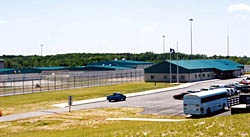
I glance at myself in the mirror, and anxiously scrutinize my outfit. Long khaki pants and a plain, loose-fitting black shirt. It’s my first day of school, and the dress code is quite strict. No jeans. Nothing too revealing, nothing too form-fitting. No dresses, no skirts. Long pants. Sleeved shirts. No blue tops. The possible ways I could violate the code seem endless.
I glance down. My shoes may be a problem. Only closed toed shoes are allowed, and all I brought with me are sandals and running shoes. I wear the running shoes as they are the pair with the only chance of passing inspection, but they may prove to be too informal.
I grab my bag. It contains my wallet and cell phone, though I know already these items will be staying in the car. I will bring only my photo ID into the school building.
Continue reading PSF project with Campus Within Walls
